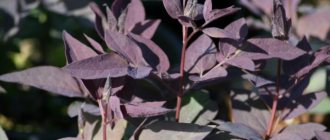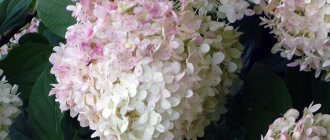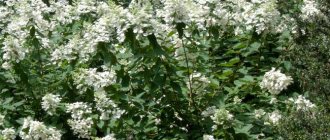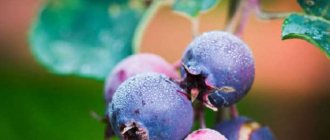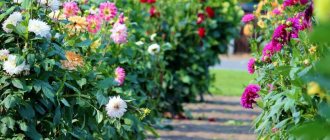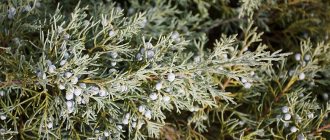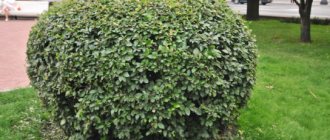The Barberry family is huge. Thorny evergreen and deciduous shrubs grow in Europe and Central Asia, North America and the Far East. But the most common are three types of barberries: common, Thunberg and Ottawa.
- Common barberry (Berberis vulgaris)
- variety Atropurpurea
- Ottawa barberry (Berberis ottawiensis) varieties Auricoma, Superba, Silver Miles
- variety Admiration, Atropurpurea Nana, Aurea, Bonanza Gold, Coronita, Dart's Red Lady, Erecta, Golden Carpet, Golden Ring, Golden Ring, Golden Rocket, Green Carpet, Harlequin, Maria, Orange Rocket, Pink Queen, Red Rocket, Silver Beauty, Starburst, Sunny
- Ecological requirements of barberries
Ottawa barberry (Berberis ottawiensis)
Hybrid between barberries Thunbergai and purple-leaved form b. ordinary. It appeared at the end of the 19th century, but is still quite rare, although it can decorate any garden. From its parents - the Thunberg barberry and the common barberry - the Ottawa one inherited all the best: in the fall its dark pink-violet leaves turn bright crimson and the bright fruits that remain on the bushes for a long time look very impressive.
The following varieties are available for sale:
Barberry Ottawa variety Auricoma
A bush up to 2–2.5 m high with bright red leaves that turn orange in autumn. It blooms with yellow-red flowers up to a centimeter in diameter, collected in inflorescences.
Barberry Ottawa variety Superba
A spreading bush up to 2.5–3 m high and up to 2–3 m in diameter, with reddish leaves and yellow flowers with a red marking. Similar to purple leaf form b. ordinary.
Barberry Ottawa variety Superba
Barberry Ottawa variety Silver Miles
Bush 2–2.5 m high with a spreading crown. The leaves are purple with a silver tint and irregular pink spots. Blooms with yellow-red flowers.
Barberry Ottawa variety Silver Miles
Application
Due to its healing properties, ordinary barberry has received quite wide application. It is used:
- In pharmacology, anti-inflammatory, choleretic, diuretic, antimicrobial, and antiseptic drugs are created from the berries of this plant.
- In cooking, the fruits have a tart and sour taste, which gives dishes a special note. The berries are not only used to make compote and jam, but they are also used to make a sauce for fish and meat, and are also added to first courses.
- In folk medicine, even in ancient Egypt, the plant was used to treat various ailments. Decoctions, teas and solutions for lotions are prepared from it.
- In cosmetology, many well-known manufacturers of cosmetics use barberry leaves and fruits to prepare creams, masks, shampoos, etc. However, you can prepare beauty “products” from these ingredients at home.
Ordinary barberry is not only a useful, but also a beautiful plant. It is especially valued by gardeners due to its high decorative qualities. Today it is quite often used in landscape design. You can make delicious homemade preparations or medicines from the berries and leaves.
Thunberg's barberry (Berberis thunbergii)
Its homeland is the mountain slopes of China and Japan. Shrub up to 1.5 m tall, with green leaves and arched shoots. Hedges and borders are made from it, dividing the area into zones; decorative groups are made up of plants with different foliage colors; single plants are planted on the lawn.
Barberry Thunberg is ideal for the Japanese garden. It is especially beautiful in autumn, when the foliage is colored in different colors.
You can find many decorative forms and varieties on sale:
Barberry Thunberg variety Admiration
A slow-growing variety up to 0.5 m tall, with a spherical, dense, uneven crown. The leaves are shiny, red-brown with a thin yellow edge. Awarded a silver medal from Plantarium, Boskoop in Holland in 2003.
Barberry Thunberg variety Admiration
Barberry Thunberg variety Atropurpurea Nana
A popular variety, obtained in 1942 in Holland, up to 0.6 m in height and up to 0.8 m in diameter. The leaves are purple in summer, red in autumn, the shoots have almost no thorns.
Barberry Thunberg variety Atropurpurea
Barberry Thunberg variety Atropurpurea Nana
Barberry Thunberg variety Aurea
A slow-growing shrub up to 1 m high. The leaves are bright, yellow, light green in the shade, pinkish or bronze in the fall.
Barberry Thunberg variety Bonanza Gold
Slow-growing shrub up to 0.4 m high and up to 0.8 m in diameter. Lemon-colored leaves. Quite resistant to sunburn.
Barberry Thunberg variety Bonanza Gold
Barberry Thunberg variety Coronita
Shrub up to 1 m high and up to 1.5 m in diameter. The leaves are bright, relatively large, purple-red with a thin yellow border.
Barberry Thunberg variety Dart's Red Lady
Shrub up to 1 m tall. The leaves are glossy, deep purple, almost black, turning bright red in autumn.
Barberry Thunberg variety Dart's Red Lady
Barberry Thunberg variety Erecta
Slow-growing thorny shrub up to 1–1.5 m tall with a narrow columnar crown. The leaves are light green and turn coral in color in autumn.
Barberry Thunberg variety Erecta
Barberry Thunberg variety Golden Carpet
A variety up to 0.9 m high and up to 1.5 m in diameter. Leaves with changing colors: pink with a red border in spring, yellow in summer, orange in autumn, light green in the shade.
Barberry Thunberg variety Golden Ring
A shrub with a height and diameter of up to 1–1.5 m. The leaves are large, purple with a bright yellow-green stripe along the edge.
Barberry Thunberg variety Golden Rocket
A variety with a dense vertical crown, up to 1.2 m high. The leaves are yellow in summer, orange-red in autumn.
Barberry Thunberg variety Golden Rocket
Barberry Thunberg variety Green Carpet
A thorny shrub up to 1 m high and up to 1.5 m in diameter. The leaves are green in summer, yellow or orange-red in autumn.
Barberry Thunberg variety Harlequin
The variety is up to 1 m high and up to 1.5 m in diameter. The leaves are burgundy with pinkish and white strokes. Kobold is a shrub up to 0.5 m in height and diameter with a very dense crown. The leaves are small, dark green, pinkish when blooming, and red in autumn.
Barberry Thunberg variety Harlequin
Barberry Thunberg variety Maria
A shrub with a very dense crown up to 1–1.5 m in height and up to 0.5–1 m in diameter. The leaves are large, yellow, often with a pink border; in autumn they are orange-red.
Barberry Thunberg variety Maria
Barberry Thunberg variety Orange Rocket
A slow-growing variety up to 1.2 m high and up to 0.6 m in diameter. The leaves are orange-red.
Barberry Thunberg variety Orange Rocket
Barberry Thunberg variety Pink Queen
A thorny shrub up to 1–1.5 m high, with a hemispherical crown. The leaves are red-purple with gray and white spots and streaks, red towards the end of the season, carmine red in the fall. It is considered one of the best among the “pink” barberries.
Barberry Thunberg variety Red Rocket
A fast-growing shrub up to 1.5 m high, with a columnar crown. The leaves are red-brown, orange in autumn.
Barberry Thunberg variety Silver Beauty
Shrub up to 1.5 m high and crown diameter up to 1 m. The leaves are silver-variegated.
Barberry Thunberg variety Starburst
A thorny shrub up to 1.2 m high and up to 1.5 m in diameter. The leaves are green when blooming, later with white and pink specks, and red in autumn.
Barberry Thunberg variety Starburst
Barberry Thunberg variety Sunny
A thorny shrub up to 1 m high, with a dense crown. The leaves are yellow, red in autumn.
Barberry Thunberg variety Tiny Gold
A dwarf shrub with a height and diameter of 0.3 m with a spherical crown. The leaves are light yellow, bright orange in autumn.
Barberry Thunberg variety Tiny Gold
Description
This plant belongs to the barberry family. Its name Berberis vulgaris (Latin) comes from the Arabic word “beri”, which means “shell”. It is its shape that resembles the leaves of a bush.
The plant grows both in mountainous areas and on plateaus. The thorny bush branches quite strongly, and is distinguished by a superficial root system (located in the upper layers of the soil). It is interesting to note that old branches have a gray bark, while young ones have yellow-brown bark. There are thorns on the shoots. They can be either ordinary or tripartite, in the sinuses of which buds are formed.
The varieties differ in the color of the leaves, the shape of the bush and its size. Common barberry can be purple, yellow or red. Thanks to its decorative properties and prickly “protection”, it is often used as a hedge, which also beneficially transforms the area.
Flowering lasts 1 month. It starts in April. The berries ripen in September-October.
Juliana barberry (Berberis julianae)
The shrub is native to Central China. An evergreen species that freezes to snow in winter, which is why its height does not exceed 50 cm. The leaves are hard, shiny, with narrow, hard teeth along the edge. The flowers are yellow, collected in dense clusters of 15 pieces. The fruits are oblong black berries.
Juliana barberry (Berberis julianae)
Beneficial features
The chemical elements that make up the berries have a number of beneficial properties. The fruits have a bactericidal, soothing, anti-inflammatory, restorative, and antioxidant effect. This is explained by the unique composition of barberry, which includes carotenoids, pectin substances, organic acids, vitamins C, E, K, micro- and macroelements.
Barberry berries have a positive effect on the body:
- cleanse the blood;
- prevent the occurrence of hepatitis;
- stop bleeding;
- relieve discomfort during menstruation;
- treat colds;
- have a strong choleretic property;
- slow down the aging process;
- relieve inflammation;
- remove toxins;
- prevent the development of malignant tumors.
In addition, the fruits of the bush have a beneficial effect on the skin, eliminating its minor defects. A hair mask made from barberry helps strengthen curls and get rid of dandruff.
Growing barberries: secrets and features
Ecological requirements of barberries
Barberries are quite light-loving, although they tolerate some shading. In full shade, decorative leaf forms of barberry (colored, with spots and borders) lose color. The more light and sun, the more vibrant the foliage will be.
They are drought-resistant, do not tolerate stagnant moisture, and are undemanding to soil conditions. They prefer neutral soils, but they can be successfully grown in slightly acidic and acidic soils. They tolerate transplantation well, even in summer, and are easy to form.
Barberry Thunberg Orange Sunrise
Landing
Container plants with ZKS tolerate replanting well throughout the season. Plants with ACS can be planted in early spring, before buds open, or in autumn, after leaf fall begins.
When planting barberry alone, place it no closer than 1.5–2 m from other plants: in crowded conditions the bush will lose its proportions. If you want to make a hedge, plant four plants per linear meter with dense planting, and two with sparse planting. At the same time, it is more convenient to dig a whole trench rather than single holes.
Care
In the second year after planting, barberries can be fed with complex fertilizers. Regular weeding, loosening and watering will also be necessary.
Barberry Thunberg Pink Queen
How to prepare red-leaved barberry bushes for winter?
Unlike some heat-loving varieties of this plant, this barberry does not need to be wrapped in burlap for the winter, but it is still better to take care of protecting young bushes or seedlings. As a rule, they are covered with needles, foliage or spruce branches.
If you place the cover not directly on the soil, but on a fine-mesh mesh, it can be very easily removed in the spring.
Cover the bushes after the soil freezes to a depth of 5 cm and the ambient temperature does not rise above five degrees below zero for more than 7 days.
In the spring, bushes should be freed from covering not only carefully so as not to damage the buds, but also in a timely manner, otherwise their growth may slow down. The exact time depends on where the barberry grows, since spring does not come to all regions at the same time.
Reproduction methods
Barberry is propagated using standard methods, including: cuttings, layering, dividing the bush and sprouting from seeds .
Seeds
Germinating seeds does not guarantee that the shoots will retain their parental qualities, so gardeners use this method quite rarely.
Cuttings
A simple and effective way to get new plants. When pruning in spring, planting material is prepared: fairly long (15–20 cm) shoots with several leaf buds.
- The lower leaves are removed, and the cut is treated with a root formation stimulator.
- Plant the cuttings in a mixture of sand and peat and cover.
- The plantings are opened daily for ventilation and watered if necessary.
The next year, the branches that have formed a strong root system can be planted in the ground.
Layering and dividing the bush
If there is already a barberry bush in the garden, then it can be propagated by dividing the bush or by layering .
The first method involves removing the mother plant from the ground and then dividing it into 2-3 fragments. All parts of the plant are planted in pre-prepared holes, well watered and fed.
Rooting cuttings is not suitable for all varieties - some plant varieties do not produce shoots suitable for rooting.
The method of propagation by layering is as follows:
- trenches are dug around the bush;
- suitable low-lying branches are placed in grooves;
- sprinkle with earth almost the entire length - the very tips of the branches remain on the surface;
- You need to water at regular intervals.
By autumn they take root and can be planted out next spring.
